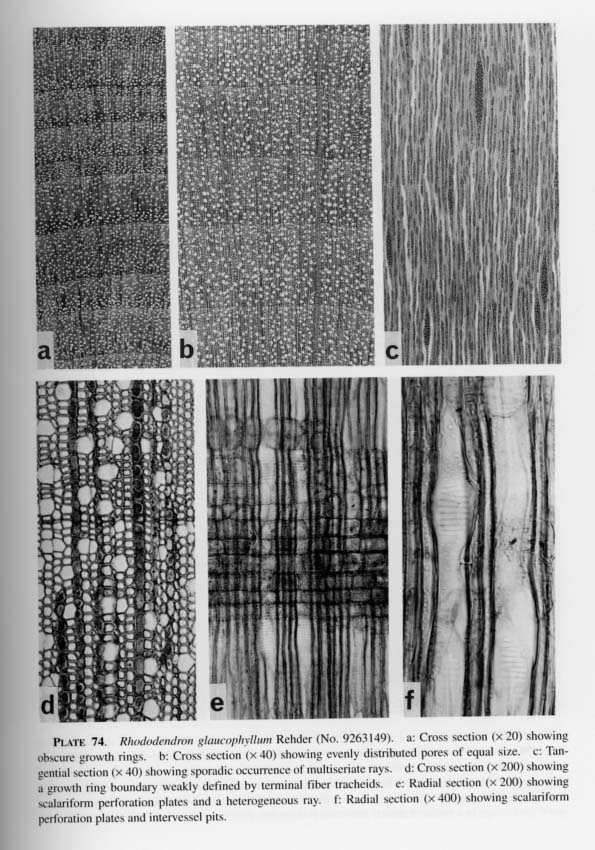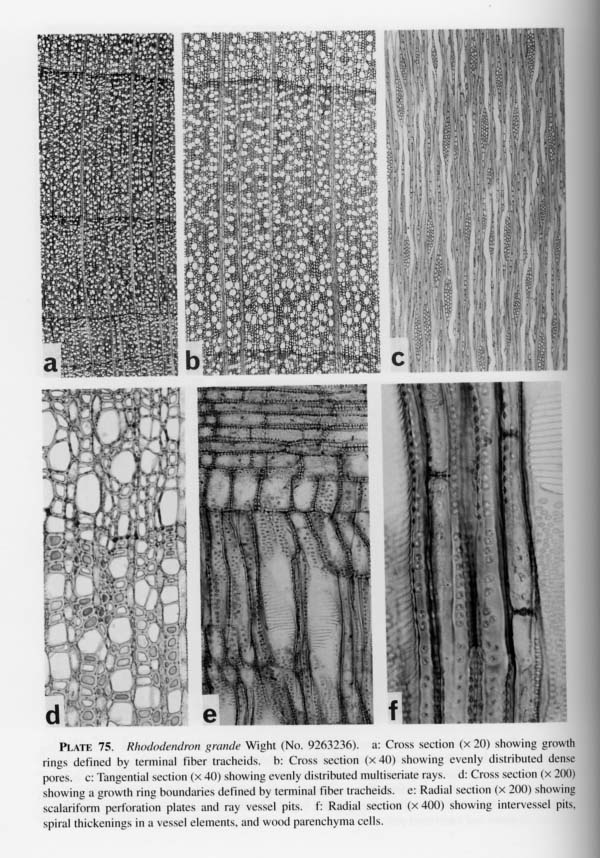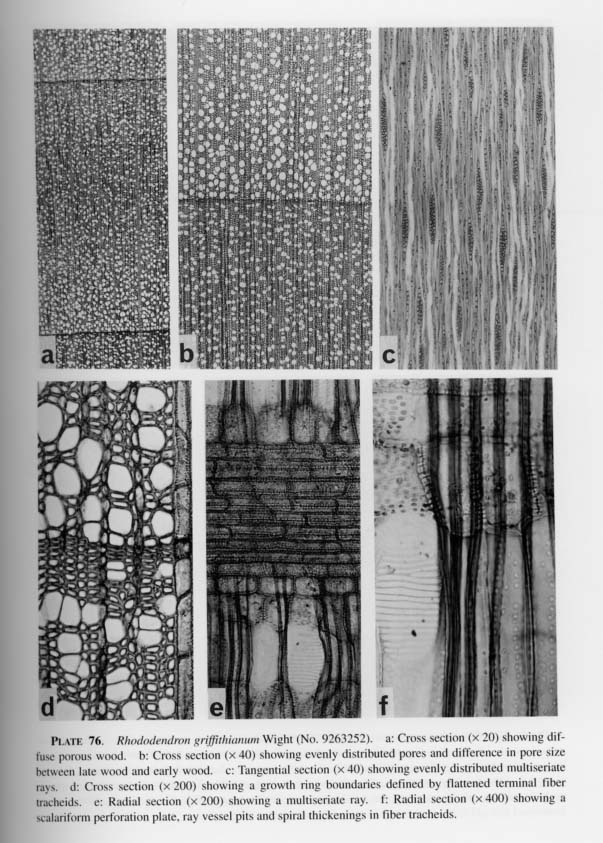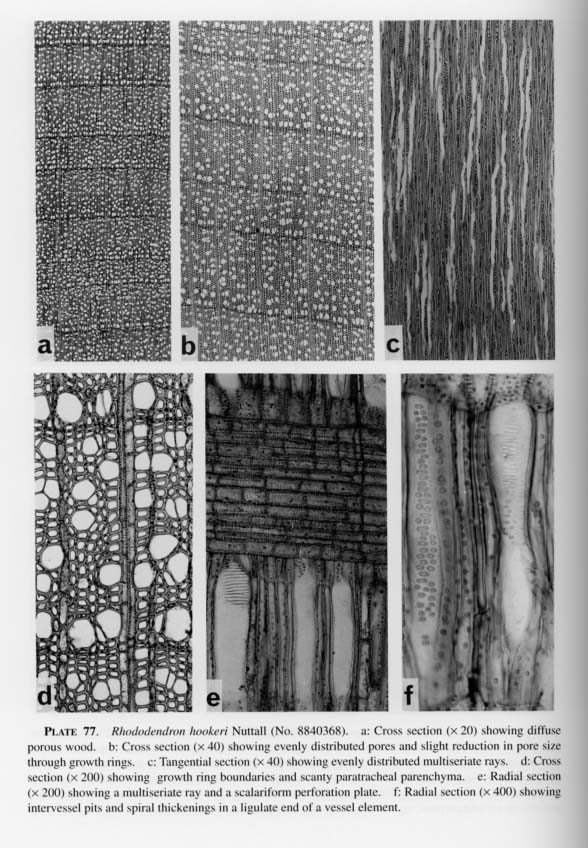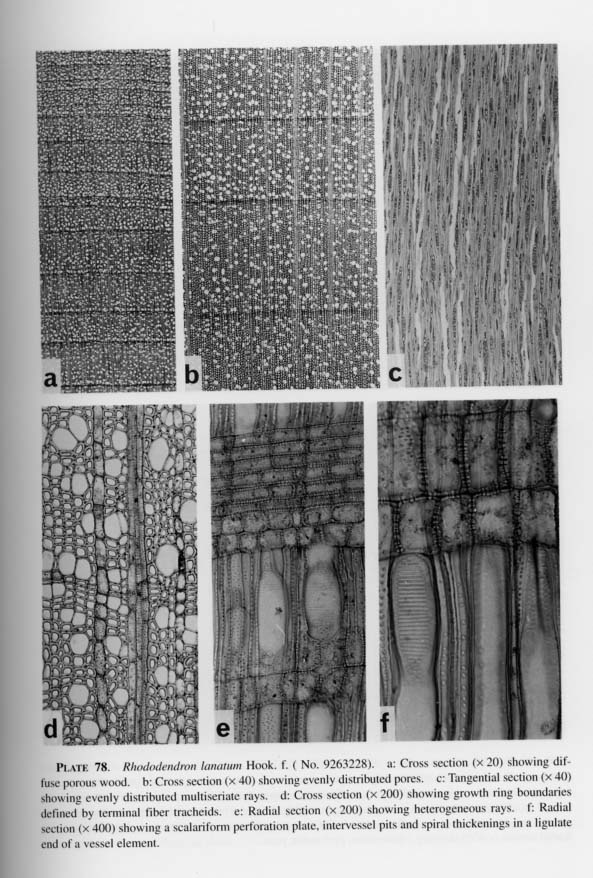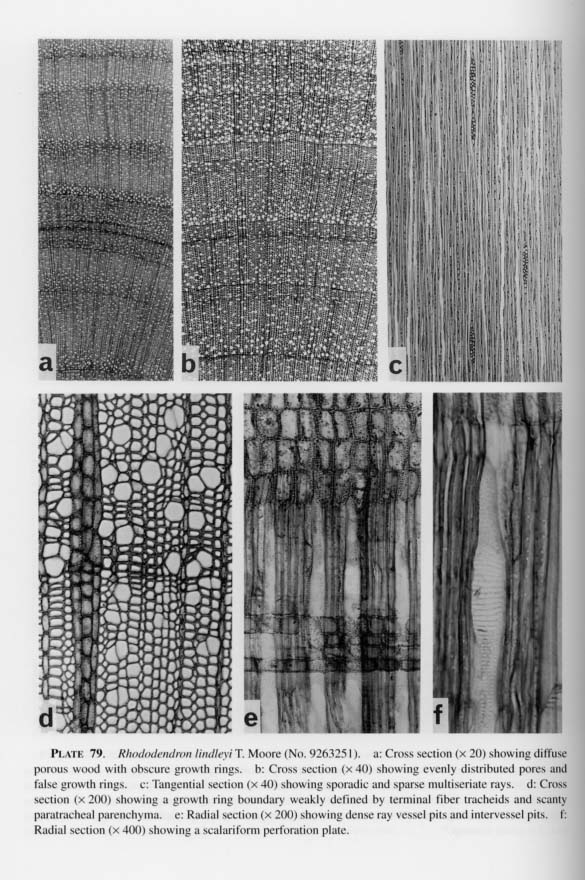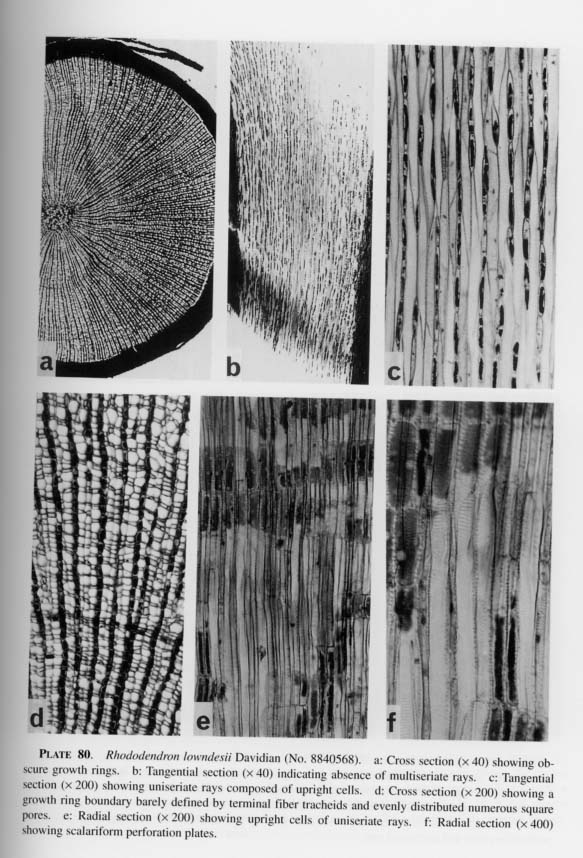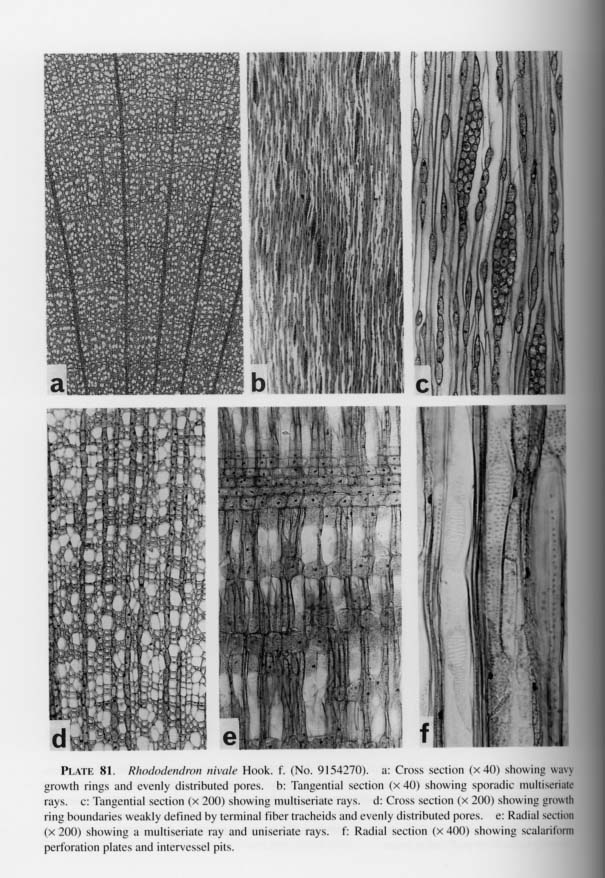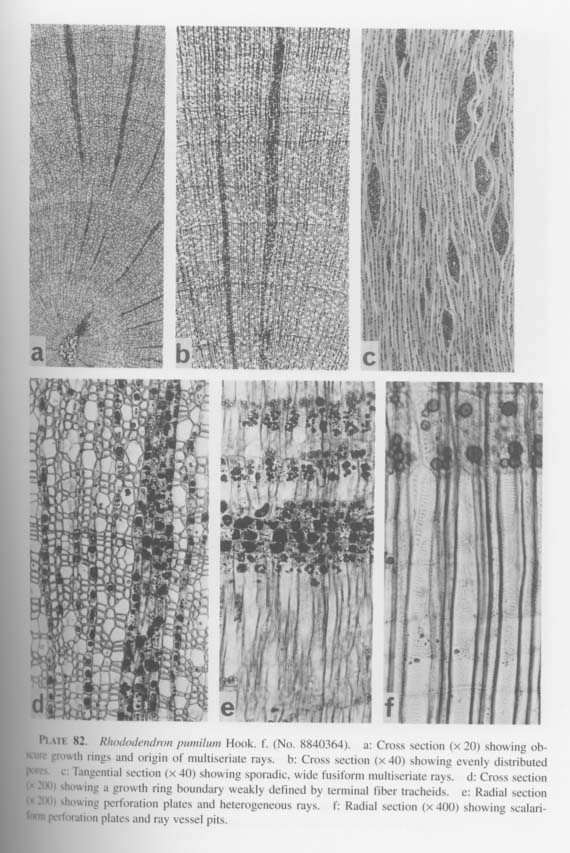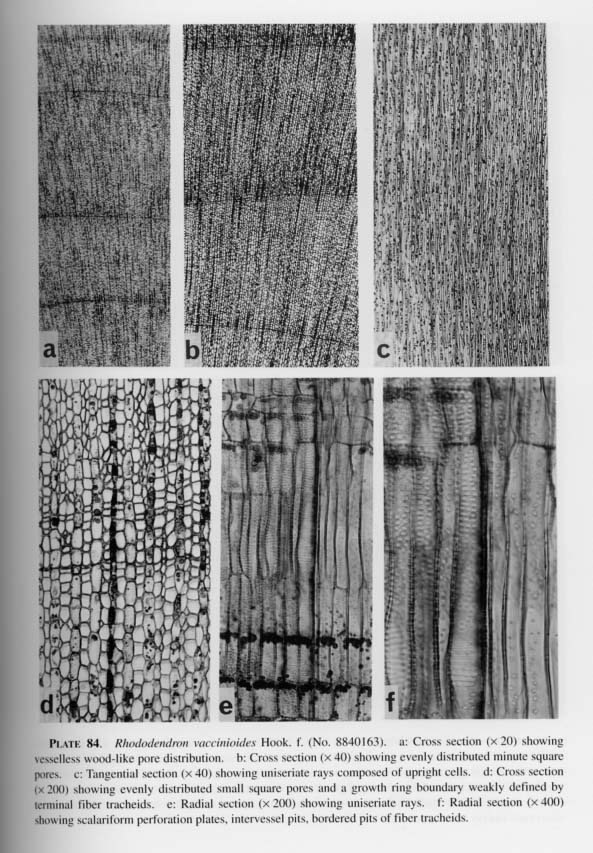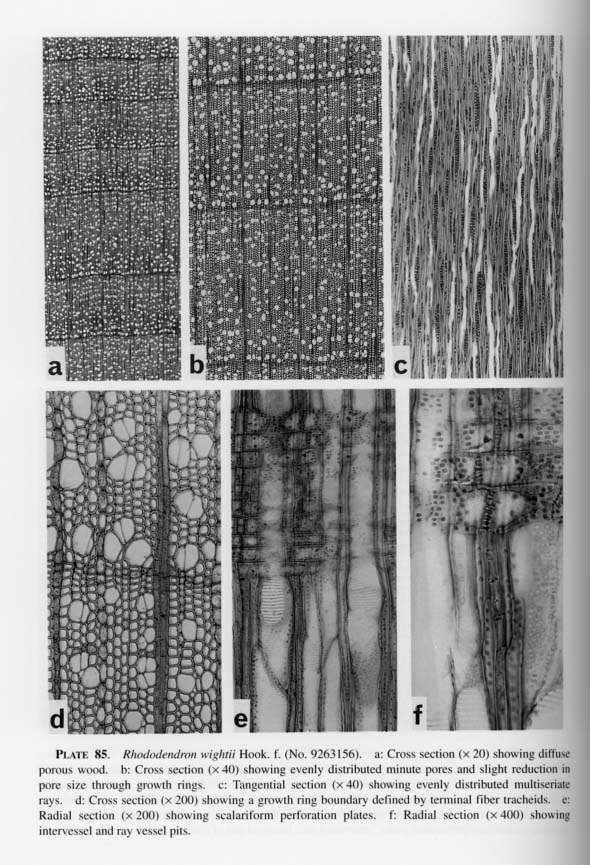WOOD STRUCTURE OF HIMALAYAN PLANTS, III
Kiyotsugu YODA and Lajmina JOSHI
| ( 3 / 4 ) |
|
Rhododendron glaucophyllum Rehder [Plate 74]
Evergreen shrubs in the subalpine zone. SPECIMENS. No. 9154072, d=0.8 cm, h=0.3 m, alt. 2800m: Koshi Zone, Sankuwasabha Distr., Gupha Pokhari (2800 m) - Angare Kharka (2930 m), H. Ohba et al., July 17, 1991. No. 9263149*, d=2 cm, h=1.1 m, alt. 3100m: Mechi Zone, Taplejung Distr., around Wolangchung Gola (3110 m), M. Suzuki et al., May 25, 1993. DESCRIPTION. Wood diffuse porous with very small pores and occasional pith flecks. Growth rings present, obscurely defined by terminal flattened fiber tracheids; false growth rings occasionally formed; growth rings fairly narrow, 0.3-0.8 mm. Pores evenly distributed, with a tendency to be slightly smaller in the late wood, 603-635/mm2; mostly solitary, or in tangential to oblique multiples of 2; pores polygonal or square in outline, (14-) 24-41 (-52) and (14-) 22-39 (-47) µm in radial and tangential diameters respectively, very thin-walled (less than 1 µm thick). Vessel elements fairly short (200-470 µm); perforation plates small and exclusively scalariform, sometimes becoming partly reticulate; bars mostly 5-16, and often thick with narrow intervals. Intervessel pits round or horizontally oblong in outline (about 3- 8 µm in horizontal diameter), with slit-like apertures, usually in single vertical files, or occasionally opposite. Spiral thickenings thick at ligulate ends of vessel elements, very thin or lacking on other inner walls. Non-perforated tracheal elements fiber tracheids. Fiber tracheids constituting ground mass of wood, fairly small rectangular or polygonal in outline, 5-15 and 5-20 µm in radial and tangential diameters respectively, usually one discontinuous row of fiber tracheids becoming flattened (about 3 µm in radial diameter) at termination of growth rings; walls fairly thin (less than 2 µm), slightly thicker in early wood than in late wood; bordered pits sparse and very small (about 3 µm in diameter), with slit-like oblique apertures; spiral thickenings absent. Wood parenchyma scanty paratracheal, 1 or 2 cells on outer margin of vessels, or rarely diffuse, sometimes at initiation of growth rings, usually difficult to recognize in cross section because of great similarity in size to fiber tracheids, very thin-walled (about 1 µm) with sparse small simple pits on radial and tangential walls, and dense ones on horizontal walls; crystals absent. Rays heterogeneous, uniseriate and multiseriate. Uniseriate rays tall and consisting wholly of upright cells, mostly 1-14 cells and 25-600 µm or sometimes taller. Multiseriate rays scattered among uniseriate rays, sporadically, 2.1-3/mm2 (No. 9263149) or evenly, 8.9-11.4/mm2 (No. 9154072); 2-4 cells and 18-60 µm wide, and 192-1053 µm tall, made up of a multiseriate central core of procumbent to square cells and low or tall uniseriate wings of square and upright cells; uniseriate wings usually with 1-11 cells. Upright and square cells more or less slender elliptic or oblong in tangential section, 20-75, 10-22 and 12-35 µm in vertical, tangential and radial diameters respectively. Procumbent cells oval or polygonal in tangential section, 8-30, 8-18 and 20-63 µm in vertical, tangential and radial diameters respectively. Crystals absent in ray cells. Ray vessel pits numerous, loosely alternate, occasionally in irregular vertical files, round, or slightly elongated horizontally with horizontal slit-like apertures and narrow borders, about 3-10 µm in horizontal diameter. Rhododendron grande Wight [Plate 75]
Evergreen trees in the upper temperate zones. SPECIMENS. No. 9263103, d=18 cm, h=10 m, alt. 2090 m: Mechi Zone, Taplejung Distr., Sewaden (2490 m) - Dongen (2260 m) - Papung (1940 m), M. Suzuki et al., May 18, 1993. No. 9263236*, d=16 cm, h=5 m, alt. 2780 m: Mechi Zone, Panchitar Distr., Gairi Kharka (3270m) - Phaleke (3350m) - Lasune Kharka (3110m) - deurali (2530 m) - Rabi Khola (1910 m) - Beteni (1980 m), S. Noshiro et al., June 21, 1993. No. 9263244, d=28 cm, h=7 m, alt. 2520 m: Mechi Zone, Panchitar Distr., Chyangthapu (1590 m) - Chamlin Danda (1750 m) Perunge (2000 m) - Dabale Deurali (2690 m), S. Noshiro et al., June 23, 1993 . DESCRIPTION. Wood diffuse porous with very small pores and occasional false rings. Growth rings present, usually defined by larger early wood pores and terminal flattened fiber tracheids; growth rings narrow, 0.3-4.3 mm. Pores evenly distributed, 317-345/mm2, gradually reduced in size toward growth ring boundaries; larger pores often gathered and occupying major area in the early wood; mostly solitary, or in tangential to radial multiples or clusters of 2-4; pores polygonal or square in outline, (8-)16-42(-55) and (9-)14-32(-40) µm in radial and tangential diameters respectively, very thin-walled (less than 1 µm thick). Vessel elements short (220-550 µm); perforation plates small and exclusively scalariform, sometimes becoming partly reticulate; bars mostly 12-26, usually thicker with a tendency to be more reticulate in late wood vessels. Intervessel pits loosely opposite, occasionally in vertical files, round or horizontally oblong in outline (about 3-8 µm in horizontal diameter), with slit-like apertures. Thin spiral thickenings present throughout vessel elements. Non-perforated tracheal elements fiber tracheids. Fiber tracheids constituting ground mass of wood, fairly small rectangular or polygonal in outline, 7-27 and 7-28 µm in radial and tangential diameters respectively, usually 1 or 2 layers of fiber tracheids ecoming flattened (5 µm or less in radial diameter) at termination of growth rings; walls thin (about 2.5 µm); bordered pits sparse and very small (about 4 µm in diameter), with slit-like oblique apertures; very thin spiral thickenings occasionally on inner walls. Wood parenchyma scanty paratracheal, 1 or 2 cells usually on outer margin of vessels, sometimes at initiation of growth rings, quite difficult to recognize in cross section because of great similarity in size to fiber tracheids, very thin-walled (about 1 µm) with sparse small simple pits on radial and tangential walls and dense ones on horizontal walls; crystals absent. Rays heterogeneous, uniseriate and multiseriate. Uniseriate rays tall and consisting mostly of upright cells with occasional square cells, mostly 1-9 cells and 30-720 µm. Multiseriate rays evenly scattered among uniseriate rays, 8.1-14,6/mm2; 2-5 cells and 16-56 µm wide, and 140-954 µm tall, made up of a multiseriate central core of procumbent cells and low uniseriate wings of square and upright cells; uniseriate wings usually with 1-7 cells. Upright and square cells more or less slender elliptic or oblong in tangential section, 30-100, 10-20 and 20-55 µm in vertical, tangential and radial diameters respectively. Procumbent cells oval or polygonal in tangential section, 8-35, 8-18 and 30-110 µm in vertical, tangential and radial diameters respectively. Crystals absent in ray cells. Ray vessel pits numerous, loosely alternate or opposite, round, or slightly elongated horizontally with horizontal slit-like apertures and narrow borders, about 3-8 µm in diameter. Rhododendron griffithianum Wight [Plate 76]
Evergreen shrubs in the temperate zone. SPECIMENS. No. 9263252*, d=6 cm, h=4 m, alt. 2390 m: Mechi Zone, Panchitar Distr., Prangbung (1970 m) − Namle Phedi (1740 m) − Namie (2110m) − Goruwale Bhanjyang (Bhanduke) (2750m) , S. Noshiro et al., June 25, 1993. No. 9263258, d=3 cm, h=1 m, alt. 2150 m: Mechi Zone, Illam Distr., Goruwale Bhanjyang (Bhanduke) (2750 m) − Maimajuwa (2160 m) − Pemeglu (1930 m) − Deurali Illam (2100 m) − Mai Pokhari (2150 m), S. Noshiro et al., June 26, 1993. DESCRIPTION. Wood diffuse porous with very small pores, and occasionally with pith flecks and false rings. Growth rings present, usually defined by larger early wood pores and terminal flattened fiber tracheids; growth rings fairly narrow, 0.2-3 mm. Pores evenly distributed, 380-519/mm2, gradually reduced in size toward growth ring boundaries, mostly solitary or in tangential to radial multiples or clusters of 2-5; pores polygonal or square in outline, (10-) 18-41 (-54) and (7-)14-32(-40) µm in radial and tangential diameters respectively, very thin-walled (less than 1µm thick). Vessel elements short (310-750 µm); perforation plates small and exclusively scalariform, sometimes becoming partly reticulate; bars mostly 13-25, usually thicker with a tendency to be more reticulate in late wood vessels. Intervessel pits loosely opposite, occasionally in vertical files, round or horizontally oblong in outline (about 3-7 µm in horizontal diameter), with slit-like apertures. Thin spiral thickenings present throughout vessel elements. Non-perforated tracheal elements fiber tracheids. Fiber tracheids constituting ground mass of wood, fairly small rectangular or polygonal in outline, 7-30 and 7-30 µm in radial and tangential diameters respectively, usually 1-4 layers of fiber tracheids becoming flattened (7 µm or less in radial diameter) at termination of growth rings; walls thin (about 2.5 µm); bordered pits sparse and very small (about 4 µm in diameter), with slit-like oblique apertures; very thin spiral occasional on inner walls. Wood parenchyma scanty paratracheal, 1 or 2 cells usually on outer margin of vessels, or rarely diffuse, sometimes at initiation of growth rings, quite difficult to recognize in cross section because of great similarity in size to fiber tracheids, very thinwalled (about 1 µm) with sparse small simple pits on radial and tangential walls, and dense ones on horizontal walls; crystals absent. Rays heterogeneous, uniseriate and multiseriate. Uniseriate rays very tall and consisting mostly of upright cells with occasional square cells, mostly 1-13 cells and 30- 800 µm. Multiseriate rays evenly scattered among uniseriate rays, 11.4-17.9/mm2; 2-4 cells and 20-45 µm wide, and 153-700 µm tall, made up of a multiseriate central core of procumbent cells and low uniseriate wings of square and upright cells; uniseriate wings usually with 1-5 cells. Upright and square cells more or less slender elliptic or oblong in tangential section, 30-110, 10-20 and 12-55 µm in vertical, tangential and radial diameters respectively. Procumbent cells oval or polygonal in tangential section, 8-30, 7-18 and 25-140 µm in vertical, tangential and radial diameters respectively. Crystals absent in ray cells. Ray vessel pits numerous, loosely alternate or opposite, round, or slightly elongated horizontally, with horizontal slit-like apertures and narrow borders, about 4-8 µm in diameter. Rhododendron hookeri Nuttall [Plate 77]
Evergreen large shrubs in the lower alpine zone. SPECIMENS. No. 8840258, d=22 cm, h=3 m, alt. 3560 m: Koshi Zone, Sakuwasabha Distr., Tutu La (4070m) - Numbuk (3500m), M. Suzuki et al., July 17, 1988. No. 8840368*, d=9 cm, h=2.3 m, alt. 3520 m: Koshi Zone, Sankuwasabha Distr., Khongma (3500m) - Tashi Gaun (2160m), M. Suzuki et al., July 31, 1988. No. 8840369, d=12 cm, h=2.2 m, alt. 3450 m: Koshi Zone, Sankuwasabha Distr., Khongma (3500 m) - Tashi Gaun (2160 m), M. Suzuki et al., July 31, 1988. DESCRIPTION. Wood diffuse porous with very small pores, and occasionally with pith flecks and false rings. Growth rings present, usually defined by larger early wood pores and terminal flattened fiber tracheids; growth rings fairly narrow, 0.3-1.4 mm. Pores evenly distributed, 385-408/mm2, gradually reduced in size toward growth ring boundaries; larger pores usually making a discontinuous row at beginning of growth rings, mostly solitary, or in tangential to radial multiples or clusters of 2-4; pores polygonal or square in outline, (8-) 18-41 (-51) and (8-)15-30(-39) µm in radial and tangential diameters respectively, very thin-walled (less than 1 µm thick). Vessel elements short (200-400 µm); perforation plates small and exclusively scalariform, sometimes becoming partly reticulate; bars mostly 12-18, and usually thicker with a tendency to be more reticulate in late wood vessels. Intervessel pits loosely opposite, occasionally in vertical files, round or horizontally oblong in outline (about 4-8 µm in horizontal diameter), with slit-like apertures. Thin spiral thickenings present throughout vessel elements. Non-perforated tracheal elements fiber tracheids. Fiber tracheids constituting ground mass of wood, fairly small rectangular or polygonal in outline, 7-25 and 7-20 µm in radial and tangential diameters respectively, usually 1-3 layers of fiber tracheids becoming flattened (7 µm or less in radial diameter) at termination of growth rings; walls thin (about 2 µm); bordered pits sparse and very small (about 4 µm in diameter), with slit-like oblique apertures; spiral thickenings absent. Wood parenchyma scanty paratracheal, 1 or 2 cells usually on outer margin of vessels, sometimes at initiation of growth rings, quite difficult to recognize in cross section because of great similarity in size to fiber tracheids, very thin-walled (about 1 µm) with sparse small simple pits on radial and tangential walls, and dense ones on horizontal walls; crystals absent. Rays heterogeneous, uniseriate and multiseriate. Uniseriate rays tall and consisting of upright and square cells, mostly 1-7 cells and 30-350 µm. Multiseriate rays evenly scattered among uniseriate rays, 10.6-15.8/mm2; 2-3 cells and 15-33 µm wide, and 84-573 µm tall, made up of a multiseriate central core of procumbent cells and low uniseriate wings of square and upright cells; uniseriate wings usually with 1-5 cells. Upright and square cells more or less slender elliptic or oblong in tangential section, 22-90, 10-20 and 8-50 µm in vertical, tangential and radial diameters respectively. Procumbent cells oval or polygonal in tangential section, 8-30, 7-15 and 20-100 µm in vertical, tangential and radial diameters respectively. Crystals absent in ray cells. Ray vessel pits numerous, loosely alternate or opposite, round, or slightly elongated horizontally, with horizontal slit-like apertures and narrow borders, about 4-7 µm in diameter. Rhododendron lanatum Hook. f. [Plate 78]
Evergreen large shrubs in the lower alpine zone. SPECIMENS. No. 9263228*, d=14 cm, h=3.5 m, alt. 3790 m: Mechi Zone, Panchitar Distr., Thulo Bhanjyang (4050 m) - Khola Tar (3820 m) - Pademeu Kharka (3750 m) - Phedung Danda (Budipani Kharka) (3720 m), S. Noshiro et al., June 19, 1993. No. 9263230, d=14cm, h=3 m, alt. 3780m: Mechi Zone, Panchitar Distr., Thulo Bhanjyang (4050 m) - Khola Tar (3820 m) - Pademeu Kharka (3750 m) - Phedung Danda (Budipani Kharka) (3720 m), S. Noshiro et al., June 19, 1993. DESCRIPTION. Wood diffuse porous with very small pores, occasionally with pith flecks and false rings. Growth rings present, usually defined by larger early wood pores and terminal flattened fiber tracheids; growth rings fairly narrow, 0.1-1.1 mm. Pores evenly distributed, 451-486/mm2, slightly reduced in size at end of growth rings, mostly solitary, or in tangential to radial multiples or clusters of 2-4; pores polygonal or square in outline, (7-)15-30(-43) and(6-)13-26(-37) µm in radial and tangential diameters respectively, very thin-walled (less than 1 µm thick). Vessel elements short (260-500 µm); perforation plates small and exclusively scalariform, sometimes becoming partly reticulate; bars mostly 14-21, usually thicker with a tendency to be more reticulate in late wood vessels. Intervessel pits loosely opposite, occasionally in vertical files, round or horizontally oblong in outline (about 3-8 µm in horizontal diameter), with slit-like apertures. Spiral thickenings present at ligulate ends of vessel elements, rarely on other inner walls. Non-perforated tracheal elements fiber tracheids. Fiber tracheids constituting ground mass of wood, fairly small rectangular or polygonal in outline, 7-27 and 7-27 µm in radial and tangential diameters respectively, usually 1-5 layers of fiber tracheids becoming flattened (5 µm or less in radial diameter) at termination of growth rings; walls thin (about 2 µm); bordered pits sparse and very small (about 4 µm in diameter), with slit-like oblique apertures; spiral thickenings absent. Wood parenchyma scanty paratracheal, 1 or 2 cells usually on outer margin of vessels, or rarely diffuse, sometimes at initiation of growth rings, quite difficult to recognize in cross section because of great similarity in size to fiber tracheids; thin-walled (about 1.5 µm) with sparse small simple pits on radial and tangential walls, and dense ones on horizontal walls; crystals absent. Rays heterogeneous, uniseriate and multiseriate. Uniseriate rays tall and consisting mostly of upright calls with occasional square cells, mostly 1-9 cells and 30-310 µm. Multiseriate rays evenly scattered among uniseriate rays, 16.6-33.7 /mm2; 2-4 cells and 19-40 µm wide, and 88-467 µm tall, made up of a multiseriate central core of procumbent cells and low uniseriate wings of square and upright cells; uniseriate wings usually with 1-7 cells. Upright and square cells more or less slender elliptic or oblong in tangential section, 30-65, 10-22 and 12-45 µm in vertical, tangential and radial diameters respectively. Procumbent cells oval or polygonal in tangential section, 7-25, 6-15 and 28-130 µm in vertical, tangential and radial diameters respectively. Crystals absent in ray cells. Ray vessel pits numerous, loosely alternate or opposite, round or slightly elongated horizontally, with horizontal slit-like apertures and narrow borders, about 4-7 µm in diameter. Rhododendron lindleyi T. Moore [Plate 79]
Evergreen shrubs in the temperate zone. SPECIMENS. No. 9263251*, d=1.5 cm, h=1.5 m, alt. 2390 m: Mechi Zone, Panchitar Distr., Prangbung (1970 m) − Namie Phedi (1740 m) − Namie (2110 m) − Goruwale Bhanjyang (Bhanduke) (2750 m) , S. Noshiro et al., June 25, 1993. No. 9263259, d=1 cm, h=1.5 m, alt. 2150m: Mechi Zone, Illam Distr., Goruwale Bhanjyang (Bhanduke) (2750 m) − Maimajuwa (2160 m) − Pemeglu (1930 m) − Deurali Illam (2100 m) − Mai Pokhari (2150 m), S. Noshiro et al., June 26, 1993. DESCRIPTION. Wood diffuse porous with very small pores and occasional pith flecks. Growth rings present, usually defined by slight differences in pore size and terminal flattened fiber tracheids; false growth rings occasionally formed; growth rings fairly narrow, 0.2-1.4 mm or less. Pores evenly distributed, 309-417/mm2 in specimen No. 9263254, slightly larger pores gathered in early wood and reduced in size and number in the late wood; in specimen No. 9263259 density constant with slight reduction in pore size toward growth ring boundaries, mostly solitary, or in tangential to oblique (occasionally radial) multiples or clusters of 2; pores polygonal or square in outline, (7-)13-23(-31) and (8-) 13-23(-32) µm in radial and tangential diameters respectively, very thin-walled (less than 1 µm thick). Vessel elements fairly short (350-600 µm); perforation plates small and exclusively scalariform, sometimes becoming partly reticulate; bars mostly 12-18, usually thicker in late wood vessels. Intervessel pits loosely opposite, partly scalariform and occasionally in vertical files, round or horizontally oblong in outline (about 3-8 µm in horizontal diameter), with slit-like apertures. Spiral thickenings restricted to ligulate ends of vessel elements. Non-perforated tracheal elements fiber tracheids. Fiber tracheids constituting ground mass of wood, fairly small rectangular or polygonal in outline, 7-22 and 5-22 µm in radial and tangential diameters respectively, usually one discontinuous layer of fiber tracheids becoming flattened (7 µm or less in radial diameter) at termination of growth rings; walls fairly thin (less than 2.5 µm), slightly thicker in early wood than in late wood; bordered pits sparse, very small (about 3-4 µm in diameter), with slit-like oblique apertures; spiral thickenings absent. Wood parenchyma scanty paratracheal, 1 or 2 cells on outer margin of vessels, or rarely diffuse, sometimes at initiation of growth rings, quite difficult to recognize in cross section because of great similarity in size to fiber tracheids, very thin-walled (about 1µm) with sparse small simple pits on radial and tangential walls, and dense ones on horizontal walls; crystals absent. Rays heterogeneous, uniseriate and multiseriate. Uniseriate rays very tall and consisting mostly of upright cells with occasional square cells, mostly 1-18 cells and 45-1480 µm and sometimes taller. Multiseriate rays scattered sporadically among uniseriate rays, 1-3.8 /mm2; 2-4 cells and 20-57 µm wide, and 306-1220 µm tall, made up of a multiseriate central core of procumbent to square cells and low uniseriate wings of square and upright cells; uniseriate wings usually with 1-13 cells. Upright and square cells more or less slender elliptic or oblong in tangential section, 40-105, 8-20 and 10-48 µm in vertical, tangential and radial diameters respectively. Procumbent cells oval or polygonal in tangential section, 10-30, 8-22 and 12-55 µm in vertical, tangential and radial diameters respectively. Crystals absent in ray cells. Ray vessel pits numerous, loosely alternate or opposite, occasionally in irregular vertical files, round, or slightly elongated horizontally with horizontal slit-like apertures and narrow borders, about 3-6 µm in horizontal diameter. Rhododendron lowndesii Davidian [Plate 80]
Deciduous shrubs in the lower alpine zone. SPECIMENS. No. 8840568*, d=0.2 cm, h=0.03 m, alt. 3460 m: Dhawaragiri Zone, Mustang Distr., Tukuche (2580 m) - Yak Kharka (3850 m), M. Suzuki et al., Aug 30, 1988. DESCRIPTION. Wood diffuse porous with very small pores. Growth rings present, but obscure, weakly defined by terminal flattened fiber tracheids; growth rings quite narrow, 0.1 mm or less. Pores evenly distributed, ca. 2300 /mm2; density constant with slight reduction in pore size toward growth ring boundaries; solitary, or in tangential or occasionally radial multiples or clusters of 2; pores polygonal or square in outline, (5-)8-14(-18) and (5-)8-14(-20) µm in radial and tangential diameters respectively, very thin-walled (less than 1 µm thick). Vessel elements fairly short (300-600 µm); perforation plates small and exclusively scalariform, sometimes becoming partly reticulate; bars few, mostly 4-10. Intervessel pits loosely opposite or in loose vertical files, round or horizontally oblong in outline (about 3-6 µm in horizontal diameter), with slit-like apertures. Spiral thickenings absent. Non-perforated tracheal elements fiber tracheids. Fiber tracheids constituting ground mass of wood, fairly small rectangular in outline, 3-12 and 4-12 µm in radial and tangential diameters respectively, usually one discontinuous layer of fiber tracheids becoming flattened (4 µm or less in radial diameter) at termination of growth rings; walls fairly thin (less than 1 µm); bordered pits sparse and very small (about 2.5 µm in diameter), with slit-like oblique apertures; spiral thickenings absent. Wood parenchyma scanty paratracheal, 1 or 2 cells on outer margin of vessels, and numerous, similar in appearance to diffuse-in-aggregate parenchyma; very thin-walled (less than 1 µm), with sparse small simple pits on radial and tangential walls and dense ones on horizontal walls; crystals absent. Rays homogeneous, uniseriate and tall, consisting mostly of upright cells with occasional square cells, mostly 1-16 cells and 40-720 µm and sometimes taller. Upright and square cells more or less slender elliptic or oblong in tangential section, 25-75, 5- 8 and 6-25 µm in vertical, tangential and radial diameters respectively. Crystals absent in ray cells. Ray vessel pits numerous, alternate, round or slightly elongated horizontally with horizontal slit-like apertures and narrow borders, about 3-4 µm in horizontal diameter. Rhododendron nivale Hook. f. [Plate 81]
Evergreen shrubs in the upper alpine zone. SPECIMENS. No. 8840322, d=1.5 cm, h=0.2 m, alt. 4630m: Koshi Zone, Sankuwasabha Distr., Merek (4450 m) - Makalu Base Camp (4680 m), M. Suzuki et al., July 22, 1988. No. 8840325, d=2 cm, h=0.2 m, alt. 4780 m: Koshi Zone, Sankuwasabha Distr., Merek (4450 m) - Makalu Base Camp (4680 m), M. Suzuki et al., July 22, 1988. No. 8840327, d=1.5cm, h=0.2 m, alt. 4880m: Koshi Zone, Sankuwasabha Distr., Around Makalu Base Camp (4680 m), M. Suzuki et al., July 24, 1988. No. 8840328, d=1.5 cm, h=0.08 m, alt. 5040 m: Koshi Zone, Sankuwasabha Distr., Around Makalu Base Camp (4680m), M. Suzuki et al., July 24, 1988. No. 8840329, d=2 cm, h=0.08 m, alt. 5080 m: Koshi Zone, Sankuwasabha Distr., Around Makalu Base Camp (4680m), M. Suzuki et al., July 24, 1988. No. 8840330, d=1.5 cm, alt. 4720 m: Koshi Zone, Sankuwasabha Distr., Around Makalu Base Camp (4680 m), M. Suzuki et al., July 24, 1988. No. 9154270*, d=0.8 cm, h=0.1 m, alt. 4800 m: Bagmati Zone, Rasuwa Distr., Langshisa Kharka (3910 m) - S of Morimoto Peak (4850 m), S. Noshiro, Sept. 2, 1991. No. 9154271, d=1.2 cm, h=0.1 m, alt. 4800 m: Bagmati Zone, Rasuwa Distr., Langshisa Kharka (3910 m) - S of Morimoto Peak (4850 m), S. Noshiro, Sept. 2, 1991. No. 9154272, d=0.8 cm, h=0.1 m, alt. 4800 m: Bagmati Zone, Rasuwa Distr., Langshisa Kharka (3910 m) - S of Morimoto Peak (4850 m), S. Noshiro, Sept. 2, 1991. DESCRIPTION. Wood diffuse porous with very small pores and occasional pith flecks. Growth rings present, usually defined by terminal flattened fiber tracheids, in the outer portion of stems, growth unequal along the circumference and greatly reduced or stopping in several directions; growth rings quite narrow, 0.35 mm or less. Pores evenly distributed, 1056-1659 /mm2, slightly reduced in size at ends of growth at ends of growth rings, solitary or in tangential to oblique (occasionally radial) multiples or clusters of 2-4; pores polygonal or square in outline, (3-) 11-32(-45) and (5-) 8-21 (-25) µm in radial and tangential diameters respectively, very thin-walled (less than 1 µm thick). Vessel elements fairly short (110-220 µm); perforation plates small and exclusively scalariform, sometimes becoming partly reticulate; bars few, mostly 5-11. Intervessel pits loosely opposite or in vertical files, round or horizontally oblong in outline (about 3-6 µm in horizontal diameter), with slit-like apertures. Spiral thickenings restricted to ligulate ends of vessel elements.. Non-perforated tracheal elements fiber tracheids. Fiber tracheids constituting ground mass of wood, fairly small, rectangular or polygonal in outline, 7-16 and 4-13 µm in radial and tangential diameters respectively, usually 1 or 2 layers of fiber tracheids becoming flattened (5 µm or less in radial diameter) at termination of growth rings; walls fairly thin (less than 1.5 µm); bordered pits sparse and very small (about 3 µm in diameter), with slit-like oblique apertures; spiral thickenings absent. Wood parenchyma scanty paratracheal, 1 or 2 cells on outer margin of vessels, occasionally numerous, similar in appearance to diffuse-in-aggregate parenchyma; occasionally initial, scattered along growth ring boundaries, very thin-walled (less than 1 µm) with sparse small simple pits on radial and tangential walls and dense ones on horizontal walls; crystals absent. Rays heterogeneous, uniseriate and multiseriate. Uniseriate rays tall and consisting mostly of upright to square cells, mostly 1-14 cells and 20-420 µm and sometimes taller. Multiseriate rays evenly scattered among uniseriate rays, 12.6-14.6/mm2 (No. 8840329) or sporadically, 3.5-6.2/mm2 (Nos. 8840330 and 9154270); 2-5 cells and 15-43 µm wide, 126-504 µm tall, made up of a multiseriate central core of procumbent to square cells and low uniseriate wings of square to upright cells; uniseriate wings usually with 1-7 cells. Upright and square cells more or less slender elliptic or oblong in tangential section, 15-52, 7-12 and 12-35 µm in vertical, tangential and radial diameters respectively. Procumbent cells oval or polygonal in tangential section, 8-18, 5-15 and 15-50 µm in vertical, tangential and radial diameters respectively. Crystals absent in ray cells. Ray vessel pits numerous, loosely alternate or opposite, occasionally in irregular vertical files, round, or slightly elongated horizontally with horizontal slit-like apertures and narrow borders, about 3-4 µm in horizontal diameter. Rhododendron pumilum Hook.f. [Plate 82]
Evergreen shrubs in the upper alpine zone. SPECIMENS. No. 8840270, d=0.4 cm, h=10 m, alt. 4120 m: Koshi Zone, Sakuwasabha Distr., Tutu La (4070m) − Numbuk (3500m), M. Suzuki et al., July 17, 1988. No. 8840364*, d=1.5cm, h=0.05 m, alt, 4100m: Koshi Zone, Sankuwasabha Distr., Cha Ding Kharka (3970 m) − Shipton Pass (4120 m) − Khongma (3500 m), M. Suzuki et al., July 30, 1988. DESCRIPTION. Wood diffuse porous with very small pores and thick rays. Growth rings present, clearly defined by terminal flattened fiber tracheids (No. 8840364) or obscure (No. 8840270); in outer portion of stems, growth unequal along the circumference, reduced or stopped in several directions; growth rings quite narrow, 0,35 mm or less. Pores evenly distributed, 886-1483 /mm2; pore size slightly reduced at ends of growth rings (No. 8840364) or equal throughout (No. 8840270), solitary, or in tangential to oblique (occasionally radial) multiples or clusters of 2-4; pores polygonal or square in outline, (6-)9-21(-23) and (9-)9-18(-27) µm in radial and tangential diameters respectively, very thin-walled (less than 1 µm thick). Vessel elements fairly short (180-320 µm); perforation plates small and exclusively scaladform, sometimes becoming partly reticulate; bars mostly 9-18. Intervessel pits loosely opposite or in vertical files, round or horizontally oblong in outline (about 3- 6 µm in horizontal diameter), with slit-like apertures. Spiral thickenings restricted to ligulate ends of vessel elements. Non-perforated tracheal elements fiber tracheids. Fiber tracheids constituting ground mass of wood, fairly small rectangular or polygonal in outline, 8-20 and 4-18 µm in radial and tangential diameters respectively, usually 1-3 layers of fiber tracheids becoming flattened (5 µm or less in radial diameter) at termination of growth rings; walls fairly thin (less than 1.5 µm); bordered pits sparse and very small (about 4 µm in diameter), with slit-like oblique apertures; spiral thickenings absent. Wood parenchyma scanty paratracheal, 1 or 2 cells on outer margin of vessels, and occasionally numerous, similar in appearance to diffuse-in-aggregate parenchyma, very thin-walled (about 1 µm) with sparse small simple pits on radial and tangential walls and dense ones on horizontal walls; crystals absent. Rays heterogeneous, uniseriate and multiseriate. Uniseriate rays very tall and consisting mostly of upright cells with occasional square cells, mostly 1-23 cells and 45- 1140 µm or sometimes taller. Multiseriate rays scattered unevenly among uniseriate rays, occasionally in aggregates, 1.1-5.7 /mm2; 2-8 cells and 8-2 µm wide, 63-1217 µm tall, made up of a multiseriate central core of procumbent to square cells and tall or low uniseriate wings of square to upright cells; uniseriate wings usually with 1-10 cells. Upright and square cells more or less slender elliptic or oblong in tangential section, 30-80, 8-18 and 8-35 µm in vertical, tangential and radial diameters respectively. Procumbent cells oval or polygonal in tangential section, 10-25, 6-22 and 15- 50 µm in vertical, tangential and radial diameters respectively. Crystals absent in ray cells. Ray vessel pits numerous, loosely alternate to scalariform, round, or slightly elongated horizontally with horizontal slit-like apertures and narrow borders, about 4- 12 µm in horizontal diameter. Rhododendron thomsonii Hook. f. [Plate 83]
Evergreen large shrubs in the subalpine and lower alpine zones. SPECIMENS. No. 8840244, d=6 cm, h=2.5 m, alt. 3290 m: Koshi Zone, Sakuwasabha Distr., Danda Kharka (2860 m) − Unshisa Kharka (3150 m) − Khongma (3500 m), M. Suzuki et al., July 15, 1988. No. 8840245*, d=24 cm, h=5.5 m, alt. 3350 m: Koshi Zone, Sakuwasabha Distr., Danda Kharka (2860m) − Unshisa Kharka (3150m) − Khongma (3500 m), M. Suzuki et al., July 15, 1988. No. 8840263, d=5 cm, h=1.3 m, alt. 3720 m: Koshi Zone, Sakuwasabha Distr., Tutu La (4070 m) − Numbuk (3500 m), M. Suzuki et al., July 17, 1988. No. 8840346, d=4 cm, h=1.3m, alt, 3440m: Koshi Zone, Sankuwasabha Distr., Ta Dasa (3900 m) − Phemathang Kharka (3380 m), M. Suzuki et al., July 28, 1988. No. 8840366, d=6 cm, h=1.7 m, alt. 3750 m: Koshi Zone, Sankuwasabha Distr., Cha Ding Kharka (3970 m) − Shipton Pass (4120 m) − Khongma (3500 m), M. Suzuki et al., July 30, 1988. No. 9154107, d=14 cm, h=4 m, alt. 3440 m: Koshi Zone, Sankuwasabha Distr., Chhippon (Chhippon Pokhari) (2980m) − Gidde (Gidde Kharka) (3500m), H. Ohba et al., July 19, 1991. No. 9154132, d=11 cm, h=2.3 m, alt. 3760 m: Koshi Zone, Sankuwasabha Distr., SW ridge of Tin Pokhari (4020-3650 m), H. Ohba et al., July 31, 1991. No. 9154203, d=7 cm, h=2 m, alt. 3600 m: Koshi Zone, Sankuwasabha Distr., Singoa Kharka (4140m) − Pahakhola (2400m), H. Ohba et al.,Aug. 11, 1991. No. 9154205, d=12cm, h=2.5 m, alt. 3490m: Koshi Zone, Sankuwasabha Distr., Singoa Kharka (4140 m) − Pahakhola (2400 m), H. Ohba et al., Aug. 11, 1991. No. 9263088, d=7 cm, h=2 m, alt. 3190 m: Mechi Zone, Taplejung Distr., Topke Gola (3590 m) − Sewaden (2490 m), M. Suzuki et al., May 17, 1993. DESCRIPTION. Wood diffuse porous with very small pores, occasionally with pith flecks and false rings. Growth rings present, usually defined by larger early wood pores and terminal flattened fiber tracheids; growth rings fairly narrow, 0.2-2.1 mm. Pores evenly distributed, 330-362/mm2, gradually reduced in size toward growth ring boundaries; usually larger pores making a discontinuous row at beginning of growth rings, mostly solitary, or in tangential to radial multiples or clusters of 2-6; pores polygonal or square in outline, (8-)16-40(-53) and (9-)14-30(-41) µm in radial and tangential diameters respectively, very thin-walled (less than 1 µm thick). Vessel elements short (210-550 µm); perforation plates small and exclusively scalariform, sometimes becoming partly reticulate; bars mostly 8-20, usually thicker and with a tendency to be more reticulate in late wood vessels. Intervessel pits loosely opposite or in vertical files, round or horizontally oblong in outline (about 3-6 µm in horizontal diameter), with slit-like apertures. Spiral thickenings restricted to ligulate ends of vessel elements. Non-perforated tracheal elements fiber tracheids. Fiber tracheids constituting ground mass of wood, fairly small rectangular or polygonal in outline, 5-22 and 5-25 µm m radial and tangential diameters respectively, usually 1-3 layers of fiber tracheids becoming flattened (8 µm or less in radial diameter) at termination of growth rings; walls thin (about 2 µm); bordered pits sparse and very small (about 4-5 µm in diameter), ith slit-like oblique apertures; very thin spiral occasional on inner walls. Wood parenchyma scanty paratracheal, 1 or 2 cells usually on outer margin of vessels, sometimes at initiation of growth rings, quite difficult to recognize in cross section because of great similarity in size to fiber tracheids, thin-walled (about 1.5 µm), with sparse small simple pits on radial and tangential walls and dense ones on horizontal walls; crystals absent. Rays heterogeneous, uniseriate and multiseriate. Uniseriate rays tall and consisting mostly of upright cells with occasional square cells, mostly 1-10 cells and 30-530 µm. Multiseriate rays evenly scattered among uniseriate rays, 11-15.8 /mm2; 2-3 cells and 20-49 µm wide, and 112-549 µm tall, made up of a multiseriate central core of procumbent cells and low uniseriate wings of square and upright cells; uniseriate wings usually with 1-5 cells. Upright and square cells more or less slender elliptic or oblongin tangential section, 20-105, 10-18 and 12-55 /urn in vertical, tangential and radial diameters respectively. Procumbent cells oval or polygonal in tangential section, 8-25, 8-20 and 20-100 µm in vertical, tangential and radial diameters respectively. Crystals absent in ray cells. Ray vessel pits numerous, loosely alternate to opposite or in vertical files, round, or slightly elongated horizontally, with horizontal slit-like apertures and narrow borders, about 4-7 µm in diameter. Rhododendron vaccinioides Hook.f. [Plate 84]
Epiphytic evergreen shrubs in the temperate zone. SPECIMENS. No. 8840163*, d=2.5 cm, h=0.4 m, alt. 1920m: Koshi Zone, Sakuwasabha Distr., Jaljale (1800 m) − Tashigaon (2160 m), M. Suzuki et al., July 12, 1988. DESCRIPTION. Wood diffuse porous with very minute pores and look like as vesselless wood. Growth rings present, defined by terminal flattened fiber tracheids; growth rings very narrow, 0.4-1.6 mm. Pores evenly distributed, ca. 1150 /mm2, with little change throughout growth rings; mostly solitary or in tangential to radial couples; pores polygonal or square in outline, (8-)11-18(-24) and (6-) 10-17 (-24) µm in radial and tangential diameters respectively, very thin-walled (less than 1 µm thick). Vessel elements fairly short (250-420 µm); perforation plates small and exclusively scalariform, sometimes becoming partly reticulate; bars mostly 9-19. Intervessel pits loosely opposite or in loose vertical files, round or horizontally oblong in outline (about 4-6 µm in horizontal diameter), with slit-like apertures. Spiral thickenings restricted to ligulate ends of vessel elements. Non-perforated tracheal elements fiber tracheids. Fiber tracheids constituting ground mass of wood, fairly small rectangular in outline, 7-25 and 8-20 µm in radial and tangential diameters respectively, walls fairly thin (l-2 µm) with large lumina, often difficult to distinguish in cross section from pores of wood parenchyma; usually one discontinuous layer of fiber tracheids becoming flattened (7 µm or less in radial diameter) at termination of growth rings; bordered pits sparse and very small (about 3 µm in diameter), with slit-like oblique apertures; spiral thickenings absent. Wood parenchyma scanty paratracheal, 1 or 2 cells on outer margin of vessels, usually quite difficult to distinguish in cross section from pores of fiber tracheids, very thin-walled (less than 1 µm), with sparse small simple pits on radial and tangential walls and dense ones on horizontal walls; crystals absent. Rays homogeneous, uniseriate and very tall, consisting mostly of upright cells with occasional square cells, mostly 1-24 cells and 35-1330 µm or sometimes taller. Upright and square cells more or less slender elliptic or oblong in tangential section, 25- 75, 12-22 and 15-70 µm in vertical, tangential and radial diameters respectively. Crystals absent in ray cells. Ray vessel pits numerous, and alternate to opposite, round orslightly elongated horizontally, with horizontal slit-like apertures and narrow borders, about 3-6 µm in horizontal diameter. Rhododendron wightii Hook. f. [Plate 85]
Evergreen large shrubs in the lower alpine zone. SPECIMENS. No. 8840272, d=5 cm, h=2.5 m, alt. 3890 m: Koshi Zone, Sakuwasabha Distr., Tutu La (4070m) − Numbuk (3500m), M. Suzuki et al., July 17, 1988. No. 8840303, d=12 cm, h=2.5 m, alt. 3760 m: Koshi Zone, Sankuwasabha Distr., Yangri Kharka (3540 m) − Ta Dasa (3900 m), M. Suzuki et al., July 20, 1988. No. 8840309, d=16 cm, h=1.7 m, alt. 4000 m: Koshi Zone, Sankuwasabha Distr., Ta Dasa (3900 m) − Merek (4450 m), M. Suzuki et al., July 21, 1988. No, 8840335, d=6 cm, h=3.5 m, alt. 3760 m: Koshi Zone, Sankuwasabha Distr., Ta Dasa (3900 m) − Phemathang Kharka (3380 m), M. Suzuki et al., July 28, 1988. No. 8840360, d=8 cm, h=1.5 m, alt. 3970 m: Koshi Zone, Sankuwasabha Distr., Phemathang Kharka (3380 m) − Cha Ding Kharka (3970 m), M. Suzuki et al., July 29, 1988. No. 8840361, d=5 cm, h=1.7 m, alt. 4130 m: Koshi Zone, Sankuwasabha Distr., Cha Ding Kharka (3970 m) − Shipton Pass (4120 m) − Khongma (3500 m), M. Suzuki et al., July 30, 1988. No. 9154125, d=5 cm, h=1.6 m, alt. 3980m: Koshi Zone, Sankuwasabha Distr., Tin Pokhari (4130m) − Banduke (4150 m), H. Ohba et al., July 24, 1991. No. 9154187, d=22 cm, h=5 m, alt. 3720 m: Koshi Zone, Sankuwasabha Distr., Shuwan Kharka (near Panch Pokhari) (4180 m) − Topke Gola (3570 m), H. Ohba et al., Aug. 7, 1991. No. 9154191, d=8 cm, h=2.5m, alt. 3580 m: Koshi Zone, Sankuwasabha Distr., Shuwan Kharka (near Panch Pokhari) (4180 m) − Topke Gola (3570 m), H. Ohba et al., Aug. 7, 1991. No. 9263081, d=7 cm, h=2.7 m, alt. 3910 m: Mechi Zone, Taplejung Distr., Topke Gola (3590 m) − (Chaun Kharka, 4020 m) − Shinsade Kharka (4100 m) − Topke Gola (3590 m), M. Suzuki et al., May 16, 1993. No. 9263156*, d=12 cm, h=2.5 m, alt. 3730m: Mechi Zone, Taplejung Distr., Deuma Kharka (3855 m) − flow junction (3575 m) − Wolangchung Gola (3110 m), M. Suzuki et al., May 28, 1993. DESCRIPTION. Wood diffuse porous with very small pores and occasional false rings. Growth rings present, usually defined by larger early wood pores and terminal flattened fiber tracheids; growth rings fairly narrow, 0.2-1.8 mm or less. Pores evenly distributed, 327-453 /mm2, gradually reduced in size toward growth ring boundaries; larger pores usually making a discontinuous row at beginning of growth rings, mostly solitary, or in tangential to radial multiples or clusters of 2-5; pores polygonal or square in outline, (7-)14-32(-47) and (6-)13-26(-38) µm in radial and tangential diameters respectively, very thin-walled (less than 1 µm thick). Vessel elements short (250-470 µm); perforation plates small and exclusively scalariform, sometimes becoming partly reticulate; bars mostly 9-16, usually thicker with a tendency to be more reticulate in late wood vessels. Intervessel pits loosely opposite or in vertical files, round or horizontally oblong in outline (about 4-8 µm in horizontal diameter), with slit-like apertures. Spiral thickenings restricted to ligulate ends of vessel elements. Non-perforated tracheal elements fiber tracheids. Fiber tracheids constituting ground mass of wood, fairly small rectangular or polygonal in outline, 5-20 and 5-22 µm in radial and tangential diameters respectively; usually 1-3 layers of fiber tracheids becoming flattened (7 µm or less in radial diameter) at termination of growth rings, walls thin (about 2 µm); bordered pits sparse and very small (about 4 µm in diameter), with slit-like oblique apertures; very thin spiral occasional on inner walls. Wood parenchyma scanty paratracheal, mostly 1 or 2 cells usually on outer margin of vessels or diffuse, sometimes at initiation of growth rings, quite difficult to recognize in cross section because of great similarity in size to fiber tracheids, thin-walled (about 2 µm), with sparse small simple pits on radial and tangential walls and dense ones on horizontal walls; crystals absent. Rays heterogeneous, uniseriate and multiseriate. Uniseriate rays tall and consisting mostly of upright cells with occasional square cells, mostly 1-9 cells and 30-300 µm. Multiseriate rays evenly scattered among uniseriate rays, 17.9-29.2 /mm2, 2 or 3 cells and 14-66 µm wide, and 109-501 µm. tall, made up of a multiseriate central core of procumbent cells and low uniseriate wings of square and upright cells; uniseriate wings usually with 1-5 cells. Upright and square cells more or less slender elliptic or oblong in tangential section, 20-102, 10-18 and 10-55 µm in vertical, tangential and radial diameters respectively. Procumbent cells oval or polygonal in tangential section, 5-25, 5-18 and 27-110 µm in vertical, tangential and radial diameters respectively. Crystals absent in ray cells. Ray vessel pits numerous, loosely alternate to opposite or in vertical files, round or slightly elongated horizontally, with horizontal slit-like apertures and narrow borders, about 4-7 µm in diameter. |
